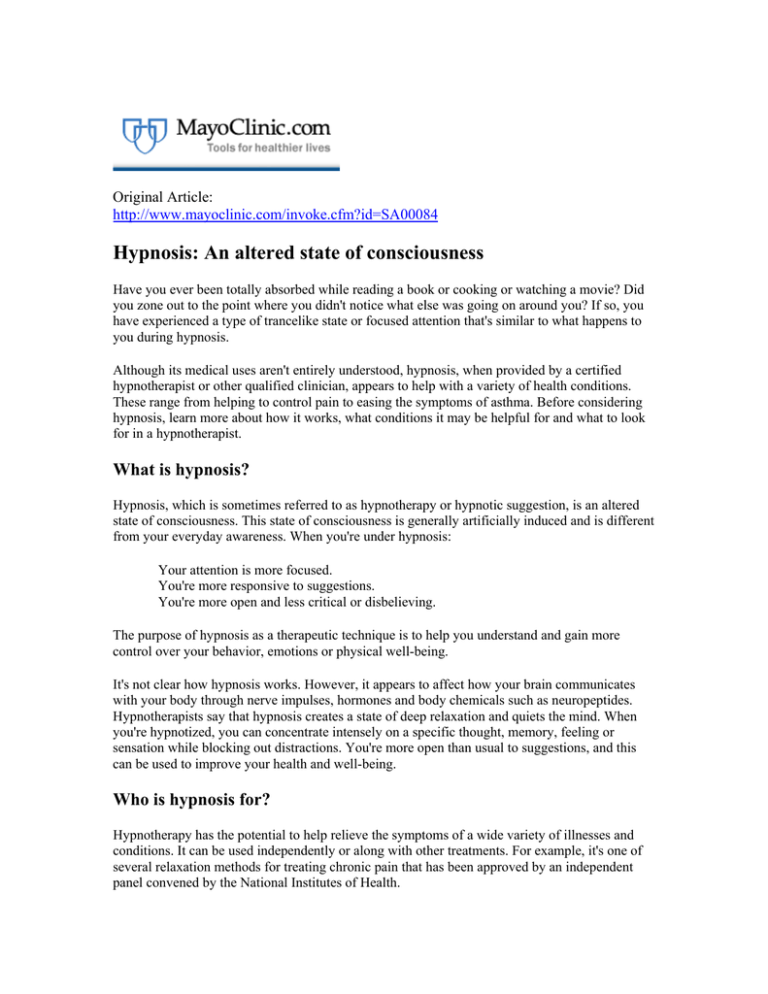
Original Article:
http://www.mayoclinic.com/invoke.cfm?id=SA00084
Hypnosis: An altered state of consciousness
Have you ever been totally absorbed while reading a book or cooking or watching a movie? Did
you zone out to the point where you didn't notice what else was going on around you? If so, you
have experienced a type of trancelike state or focused attention that's similar to what happens to
you during hypnosis.
Although its medical uses aren't entirely understood, hypnosis, when provided by a certified
hypnotherapist or other qualified clinician, appears to help with a variety of health conditions.
These range from helping to control pain to easing the symptoms of asthma. Before considering
hypnosis, learn more about how it works, what conditions it may be helpful for and what to look
for in a hypnotherapist.
What is hypnosis?
Hypnosis, which is sometimes referred to as hypnotherapy or hypnotic suggestion, is an altered
state of consciousness. This state of consciousness is generally artificially induced and is different
from your everyday awareness. When you're under hypnosis:
Your attention is more focused.
You're more responsive to suggestions.
You're more open and less critical or disbelieving.
The purpose of hypnosis as a therapeutic technique is to help you understand and gain more
control over your behavior, emotions or physical well-being.
It's not clear how hypnosis works. However, it appears to affect how your brain communicates
with your body through nerve impulses, hormones and body chemicals such as neuropeptides.
Hypnotherapists say that hypnosis creates a state of deep relaxation and quiets the mind. When
you're hypnotized, you can concentrate intensely on a specific thought, memory, feeling or
sensation while blocking out distractions. You're more open than usual to suggestions, and this
can be used to improve your health and well-being.
Who is hypnosis for?
Hypnotherapy has the potential to help relieve the symptoms of a wide variety of illnesses and
conditions. It can be used independently or along with other treatments. For example, it's one of
several relaxation methods for treating chronic pain that has been approved by an independent
panel convened by the National Institutes of Health.
According to preliminary studies, hypnotherapy can be used to:
Treat pain during childbirth and reduce labor time
Control bleeding and pain during dental and surgical procedures
Relieve cramping and other symptoms associated with irritable bowel syndrome (IBS)
Reduce blood pressure and regulate blood flow
Enhance the body's immune system and ability to fight infection
Control nausea and vomiting caused by chemotherapy
Reduce the intensity or frequency of migraine headaches in children and teenagers
Treat and ease the symptoms of asthma
Hasten the healing of some skin diseases
Improve psoriasis and atopic dermatitis
Change negative behaviors, such as smoking, bedwetting and overeating
Reduce fear, stress and anxiety
Eliminate or decrease the intensity of phobias
Although hypnosis may have the potential to help with a wide variety of conditions, it's not a
magic bullet. It's typically used as one part of a broader treatment plan rather than as a standalone therapy. Like any other therapy, it can be very helpful to some people and fail with others.
It seems to work best when you're highly motivated and your therapist is well trained and
understands your particular problem.
Types of hypnosis
A variety of hypnotic techniques exists. The approach you choose depends on what you want to
accomplish, as well as your personal preferences. Your hypnotherapist may make a
recommendation regarding the best technique for your particular situation.
For example, in one method, a hypnotherapist leads you into hypnosis by talking in gentle,
soothing tones and describing images that create a sense of relaxation, security and well-being.
While you're under hypnosis, the hypnotherapist suggests ways for you to achieve specific goals
— for example, reducing pain or stress or helping to eliminate the cravings associated with
smoking cessation.
In another technique, once you're under hypnosis the hypnotherapist helps stimulate your
imagination by suggesting specific mental images to see in your mind's eye. This conscious
creation of vivid, meaningful pictures in your mind is called mental imagery, and it's a powerful
way to help bring about what you want to achieve. For example, hypnotherapists can help athletes
specifically visualize what they want to accomplish before they perform it physically.
Self-hypnosis is a third technique. A certified hypnotherapist needs to teach you how to induce a
state of hypnosis in yourself. You then can use this skill to help yourself.
Although hypnotherapists, like other health care practitioners, each have their own style, expect
some common elements:
A typical session lasts from 30 to 60 minutes.
The number of sessions can range from one to a series of several.
You generally bring yourself out of hypnosis at the end of a session.
You can usually resume your daily activities immediately after a session.
Myths about hypnosis
If you've ever seen a "hypnotist" who uses trance states as entertainment in a stage act, you've
probably witnessed several of the myths about hypnosis in action. Legitimate clinical
hypnotherapy practiced by a qualified professional is not the same process as that performed on
stage.
Myth: When you're under hypnosis, you surrender your free will.
Reality: Hypnosis is a heightened state of concentration and focused attention. When you're
under hypnosis, you don't lose your personality, your free will or your personal strength.
Myth: When you're under hypnosis, the hypnotherapist controls you.
Reality: You do hypnosis voluntarily for yourself. A hypnotherapist only serves as a
knowledgeable guide or facilitator.
Myth: Under hypnosis, you lose consciousness and have amnesia.
Reality: A small number of people who go into a very deep hypnotic state experience
spontaneous amnesia. However, most people remember everything that occurs under hypnosis.
Myth: You can be put under hypnosis without your consent.
Reality: Successful hypnosis depends on your willingness to experience it. Even with voluntary
participation, not everyone can be led into a hypnotic state.
How to choose a qualified professional
Hypnosis as a practice is not regulated in most states, so it pays to be very careful when selecting
a therapist. Certified lay hypnotists are individuals who have completed 200 or more hours of
training in hypnosis but don't have additional professional health care training. Licensed health
care professionals who practice hypnotherapy, such as psychologists, doctors and social workers,
are trained in hypnosis in addition to their university training.
Apply the same care in choosing a hypnotherapist as you would a doctor. Ask someone you trust
for recommendations. When you find a potential hypnotherapist, ask questions such as:
Do you have training in a field such as psychology, medicine, social work or dentistry?
Are you licensed in your specialty in this state?
Where did you go to school, and where did you do your internship, residency program or both?
If you're a lay hypnotist, how much training have you had and from which school?
What professional organizations do you belong to?
How long have you been in practice?
When conducted under the care of a trained therapist, hypnosis is generally safe as a
complementary treatment method.
By Mayo Clinic staff
December 19, 2003
© 1998-2005 Mayo Foundation for Medical Education and Research (MFMER). All rights
reserved. A single copy of these materials may be reprinted for noncommercial personal use
only. "Mayo," "Mayo Clinic," "MayoClinic.com," "Mayo Clinic Health Information," "Reliable
information for a healthier life" and the triple-shield Mayo logo are trademarks of Mayo
Foundation for Medical Education and Research.




